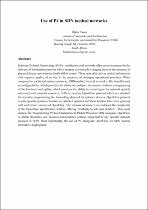JavaScript is disabled for your browser. Some features of this site may not work without it.
- ResearchSpace
- →
- Research Publications/Outputs
- →
- Conference Publications
- →
- View Item
| dc.contributor.author |
Nkosi, Mpho C

|
|
| dc.date.accessioned | 2018-07-20T09:01:43Z | |
| dc.date.available | 2018-07-20T09:01:43Z | |
| dc.date.issued | 2018-05 | |
| dc.identifier.citation | Nkosi, M.C. 2018. Use of P4 in SDN tactical networks. The Military Information Communication Symposium of South Africa (MICSA 2018), May 2018, CSIR ICC, Pretoria, South Africa | en_US |
| dc.identifier.uri | http://www.micssa.co.za/pages/programme.html | |
| dc.identifier.uri | http://hdl.handle.net/10204/10317 | |
| dc.description | Presentation delivered at the Military Information Communication Symposium of South Africa (MICSA 2018), May 2018, CSIR ICC, Pretoria, South Africa | en_US |
| dc.description.abstract | Software Defined Networking (SDN) - enabled tactical networks offer an environment for the delivery of information services which support dynamically changing force in the presence of physical threats and wherein bandwidth is scarce. These networks deliver critical information with required quality of service in the presence of changing operational priorities. When compared to traditional tactical networks, SDN-enabled tactical networks offer benefits such as configurability, which provides the ability to configure the network without re-engineering of the hardware and agility, which provides the ability to re-configure the network quickly and easily with minimal resources. SDN is based on OpenFlow protocol which is a standard for remotely programming the forwarding plane of the network devices. OpenFlow protocol overtly specifies protocol headers on which it operates and these headers have been growing with each newer version of OpenFlow. The increase of headers has endorsed the complexity of the OpenFlow specification without offering flexibility to add new headers. This work analyse the Programming Protocol-Independent Packet Processor (P4) alongside OpenFlow to enable flexibility and protocol-independence without being tied to any specific network protocol in SDN. Most importantly, the use of P4 alongside OpenFlow for SDN tactical networks is highlighted. | en_US |
| dc.language.iso | en | en_US |
| dc.relation.ispartofseries | Worklist;21073 | |
| dc.subject | Software defined networking | en_US |
| dc.subject | SDN | en_US |
| dc.subject | Tactical networks | en_US |
| dc.title | Use of P4 in SDN tactical networks | en_US |
| dc.type | Conference Presentation | en_US |
| dc.identifier.apacitation | Nkosi, M. C. (2018). Use of P4 in SDN tactical networks. http://hdl.handle.net/10204/10317 | en_ZA |
| dc.identifier.chicagocitation | Nkosi, Mpho C. "Use of P4 in SDN tactical networks." (2018): http://hdl.handle.net/10204/10317 | en_ZA |
| dc.identifier.vancouvercitation | Nkosi MC, Use of P4 in SDN tactical networks; 2018. http://hdl.handle.net/10204/10317 . | en_ZA |
| dc.identifier.ris | TY - Conference Presentation AU - Nkosi, Mpho C AB - Software Defined Networking (SDN) - enabled tactical networks offer an environment for the delivery of information services which support dynamically changing force in the presence of physical threats and wherein bandwidth is scarce. These networks deliver critical information with required quality of service in the presence of changing operational priorities. When compared to traditional tactical networks, SDN-enabled tactical networks offer benefits such as configurability, which provides the ability to configure the network without re-engineering of the hardware and agility, which provides the ability to re-configure the network quickly and easily with minimal resources. SDN is based on OpenFlow protocol which is a standard for remotely programming the forwarding plane of the network devices. OpenFlow protocol overtly specifies protocol headers on which it operates and these headers have been growing with each newer version of OpenFlow. The increase of headers has endorsed the complexity of the OpenFlow specification without offering flexibility to add new headers. This work analyse the Programming Protocol-Independent Packet Processor (P4) alongside OpenFlow to enable flexibility and protocol-independence without being tied to any specific network protocol in SDN. Most importantly, the use of P4 alongside OpenFlow for SDN tactical networks is highlighted. DA - 2018-05 DB - ResearchSpace DP - CSIR KW - Software defined networking KW - SDN KW - Tactical networks LK - https://researchspace.csir.co.za PY - 2018 T1 - Use of P4 in SDN tactical networks TI - Use of P4 in SDN tactical networks UR - http://hdl.handle.net/10204/10317 ER - | en_ZA |






